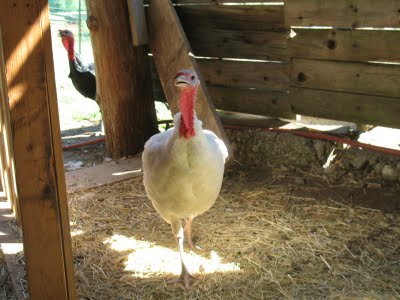TURKEY
General Information
Turkeys are kept mainly for meat. Sexes can be separated by vent system of sexing at the time of hatching. Males are heavier than females. Mature males of all varieties have conspicuous black beards attached to the skin of the upper region. Dewbill or snood, a fleshy protuberance near the base of the beak, is relatively large, plump and elastic in males. It is relatively small, thin and non-elastic in females. Most of the modern turkeys have been selected for rapid growth and wide breast conformation. Under natural matings fertility is usually low and hence artificial insemination is commonly employed to obtain desired fertility levels. In natural mating, a male female ratio of 1:5 is desirable. The average age at first egg is around 30 weeks. Average egg production is around 100 eggs/hen turkey/year. Eggs of a normal turkey weigh around 70 g. Egg is noticeably pointed at one end with strong shell. Turkeys similar to chicken lay their eggs during the day time.
When not needed for hatching turkey eggs can be used as human food. Eggs are palatable and nutritious as chicken eggs. Hatching period is 28 days. With proper care turkeys attain 4 kg body weight at about 12-14 weeks of age. Although body weight increases with advancement of age, feed efficiency is adversely affected. At 20-24 weeks of age they attain a body weight of 8 to 9 kg. Feed efficiency is naturally poor for small turkeys than large turkeys.
( Source: www.vuatkerala.org )
Rearing system
Turkeys can be reared under free range or intensive system.
Free range system of rearing
Advantages

Free Range Rearing
In the free range system, in one acre of fenced land we can rear 200-250 adult turkeys. Shelter should be provided during night at the rate of 3-4 sq.ft. per bird. They should be protected from predators during scavenging. Planting of trees is desirable for providing shade and cooler environment. The range should be rotated which will help to reduce incidence of parasite infestation.
Free range feeding
Since turkeys are very good scavengers, it can consume earthworms, small insects, snails, kitchen waste and termites. which are rich in protein and that will reduce the feed cost by fifty percent. Apart from this leguminous fodder like Lucerne, Desmanthus, Stylo etc, can be fed. To avoid leg weakness and lameness in free ranging birds, calcium should be supplemented at the rate of 25gm per week per bird in the form of oyster shell. Ten percent of feed can be substituted with vegetable waste to reduce the cost of feed.
Health cover
Turkeys in the free range system are highly susceptible for internal (round worms) and external parasites (fowl mite). Hence once a month deworming and dipping is essential to improve the growth of the birds.
Floor, feeder and water space requirement of turkeys:
Age |
Floor Space(Sq .Ft) |
Feeder Space (cm) (Linear feeder) |
Water Space (cm)
(Linear water) |
| 0-4 weeks |
1.25 |
2.5 |
1.5 |
| 5-16 weeks |
2.5 |
5.0 |
2.5 |
| 16-29 weeks |
4.0 |
6.5 |
2.5 |
| Turkey breeder |
5.0 |
7.5 |
2.5 |
Intensive system of rearing:
Advantages:

Intensive Rearing System
Housing
-
Housing protects turkeys form sun, rain, wind, predators and provides comfort.
-
In hotter parts of the country the long axis of the house should run from east to west.
-
The distance between two houses should be at least 20 meters and the young stock house should be at least 50 to 100 meters away from the adult house.
-
The width of the open house should not exceed 9 meters.
-
The height of the house may vary from 2.6 to 3.3 meters from the floor to roof
-
An overhang of one meter should be provided to avoid the rainwater splash.
-
The floor of the houses should be cheap, durable and safe preferably concrete with moisture proof.
When turkeys are reared under deep litter system, the general managemental conditions are similar to that of chicken but care should be taken to provide adequate floor, water and feeder space to accommodate the large bird.
( Source: Farm Digest, Canara Bank, July-September 2008)
| 

